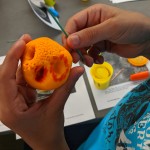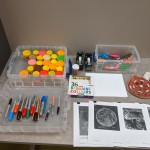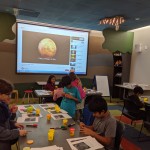 In honor of the 50th anniversary of the lunar landing, Be the Scientist, a STEAM program for grades 3-5, explored the lunar surface this month. This program series generally has a short slide presentation to introduce the topic and the hands on challenge. Additionally, this month we were able to feature a lunar sample disk from NASA Johnson Space Center. Here’s what we did.
In honor of the 50th anniversary of the lunar landing, Be the Scientist, a STEAM program for grades 3-5, explored the lunar surface this month. This program series generally has a short slide presentation to introduce the topic and the hands on challenge. Additionally, this month we were able to feature a lunar sample disk from NASA Johnson Space Center. Here’s what we did.
The program was based off of this Explore the Moon activity from NASA. We began with a slide presentation that asked participants to share what they knew about the moon (Earth’s moon, to be precise) and we compared participant responses to information provided from NASA. Because of the 50th anniversary, a lot of participants had learned about the moon relatively recently and were eager to share their knowledge.
We then explored specific surface features as outlined by the linked activity. We made slides with images to provide examples and also provided printed images of the moon’s surface to help connect concepts. Once we established a baseline understanding of the lunar surface, we introduced the hands-on challenge: use Play-doh and provided tools to create individual models of the lunar surface. We asked participants to include the features we covered in the slide presentation, like craters, rilles, and mountains.
The participants loved this challenge! Some even decided to change the parameters by designing their own planets and explained the composition and surface features while also coming up with creative names. As facilitators, we were thrilled to see such enthusiasm and creativity around this activity. We also played Gustav Holst’s “The Planets” on YouTube as participants created their moons and/or planets.
As participants finished their creations, they were able to make personalized flags to add to the Play-doh. Then we regrouped and went over what was learned, what worked well, and what they’d like to learn more about. We ended the program with a one word checkout about their overall experience and most said “cool.”






That looks like it was a great program. I’ve wanted to borrow the NASA resources, but haven’t been able to so far.
You have to be certified to borrow from NASA. I’m not sure how often they provide certification sessions. I did mine at a training in 2015 at LPI.